Why is this ‘Fantastic Jurassic Coast, England’ known as a Mesozoic masterpiece
Jurassic Coast, England
The Jurassic Coast is a 152-kilometre-long stretch of coastline in southern England, situated within the counties of Dorset and Devon. It is declared a UNESCO World Heritage Site recognised for its outstanding rocks, fossils and landforms. Geology is the centre stage on the Jurassic Coast. It is the only place on Earth where rocks from the Triassic, Jurassic and Cretaceous Periods can be seen in one place. This coastline is special because it preserves Earth’s history from 250 to 65 million years ago. This is the time when the dinosaurs roamed the planet. During this time the coast changed a lot, going from a desert to a tropical sea, to a coastal forest and swamp, and to a shallow sea. There are many fossils scattered along the coastline and on the cliffs of the coastline. The most common type of fossil here is marine, including famous pyrite “fool’s gold” ammonites, belemnites, and even bones of large sea-dwelling marine reptiles like the Ichthyosaurs. In addition to the fossils, there are wonderful coastal and geomorphological features like arches, pinnacles and sea stacks.
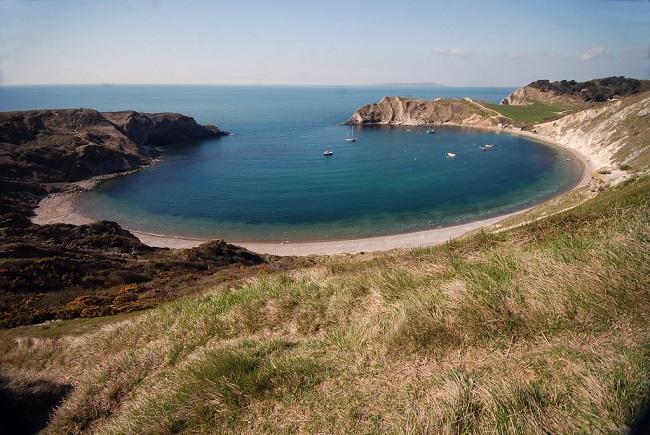
Jurassic coast Dorset England History and Geology
The Jurassic Coast stretches from Orcombe Point in East Devon to Old Harry Rocks in East Dorset, a distance of 152 km. It is declared a Unesco World Heritage site in 2001. an acute pyramidal sculpture marks the western end of the heritage site; this is built out of fragments of the different types of rocks to be seen along the coast. The cliffs on this part of the coast are being eroded away and landslides occur. These processes reveal successive layers of sedimentary rock, uncovering the geological history of the modern coastline.
The fossils found in the area and the coastal features of this dynamic coast help the researcher to sturdy on the Mesozoic era. The fossils found in abundance along this coastline provide evidence of how animals and plants evolved in this region. During the Triassic, this area was a desert, while in the Jurassic it was part of a tropical sea, and in the Cretaceous, it was covered by swamps. The fossilised remains of the animals and plants that lived in those periods are very well preserved, providing a wealth of information. Fossil groups found here include crustaceans, insects, molluscs, echinoderms, fish, amphibians, reptiles and a few mammals. At Lulworth Cove, there is a fossil forest of conifers, tree ferns and cycads.
Jurassic Coast England consists of Triassic, Jurassic and Cretaceous cliffs, of a Mesozoic era in geological history. The site can be best viewed from the sea when the dipping nature of the rock strata becomes apparent. In East Devon, the coastal cliffs consist of steep cliffs of red sandstone from the Triassic, and at Budleigh Salterton, the gravel cliffs contain red quartzite pebbles which accumulate on the beach below.
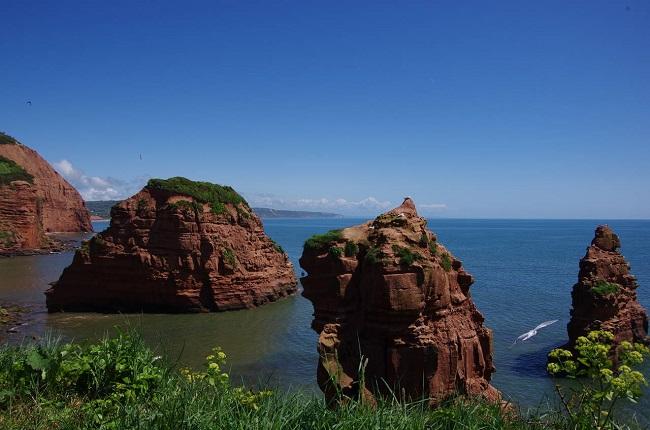
Around Lyme Regis and Charmouth the cliffs showing of Jurassic clays and shale, and here landslips are common. Chesil Beach is a good example of a barrier beach and stretches for 29 km. The beach encloses an intertidal lagoon which is an internationally important Ramsar Convention site known for its biodiversity. At Lulworth Cove, the waves cut through the resistant Portland stone and created a horseshoe-shaped cove by eroding the softer sands and clays. Another outstanding feature of this part of the coast is Durdle Door, a natural arch. Sea stacks and pinnacles, such as Old Harry Rocks at Handfast Point, have been formed by the erosion of the chalk cliffs.
This coast shows excellent examples of landforms, including the natural arch at Durdle Door, the cove and limestone folding at Lulworth Cove and a tied island, the Isle of Portland. Chesil Beach is a fine example of both a tombolo and a storm beach. The site has stretches of both concordant and discordant coastlines. At Lyme Regis, geologists have identified 71 layers of rock, each one containing fossils of a different species of ammonite.
Jurassic Coast England Attractions
Jurassic Coast England is one of the most popular destinations in Britain, attracting millions of visitors from all over the world each year. To discover all of its secrets and treasures would take a lifetime. Within these rocks are countless landscapes formed and shaped by time. The pristine beaches, charming seaside towns and wide-ranging adventure experiences are just amazing. These are the best Attraction at Jurassic Coast.
The famous Jurassic Coast Durdle door
The best-known attraction is Durdle Door, a 60-meter-tall limestone arch over the sea linking two remote beaches, and one of Devon’s most popular spots. The place is best viewed from the coast as you walk over the cliffs from Lulworth Cove, a perfect semi-circle of sea enclosed within white chalk cliffs.
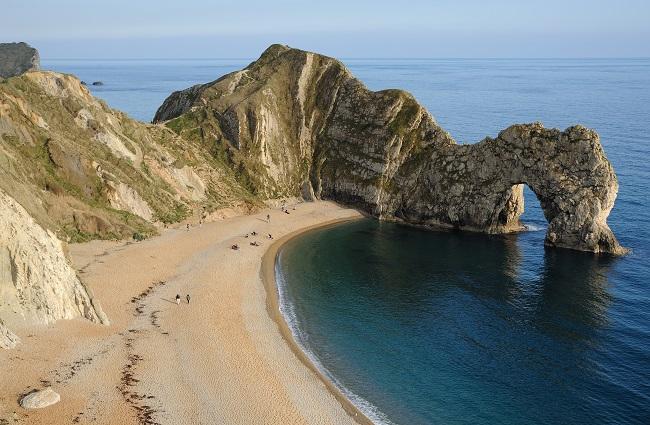
Old Harry Rocks
Old Harry Rocks are three chalk formations, including a stack and a stump, located at Handfast Point, on the Isle of Purbeck in Dorset. These structures mark the eastern point of the Jurassic Coast. Thousands of years ago, Old Harry and The Needles (another chalk rock formation) on the Isle of Wight were linked by a line of chalk hills that eroded away during the last ice age. On a clear day, one can see The Needles from Studland Bay.
Chesil Beach
Chesil Beach in Dorset, England is one of three major shingle beach structures in Britain. Its name is derived from the Old English ceosel meaning “gravel” or “shingle”. It runs for a length of 29 kilometres from West Bay to the Isle of Portland and in places is up to 15 metres high and 200 metres wide. This is a barrier beach linking the Isle of Portland with the mainland and forming a wildlife-rich brackish-water lagoon at the Fleet.
The pebbles on Chesil Beach are graded in size from potato-sized near Portland to pea-sized at Bridport and are made up of mainly flint and chert from the Cretaceous and Jurassic rocks. Behind Chesil Beach lies a large saline lake known as the Fleet Lagoon, one of the few remaining undisturbed brackish lagoons left in the world.
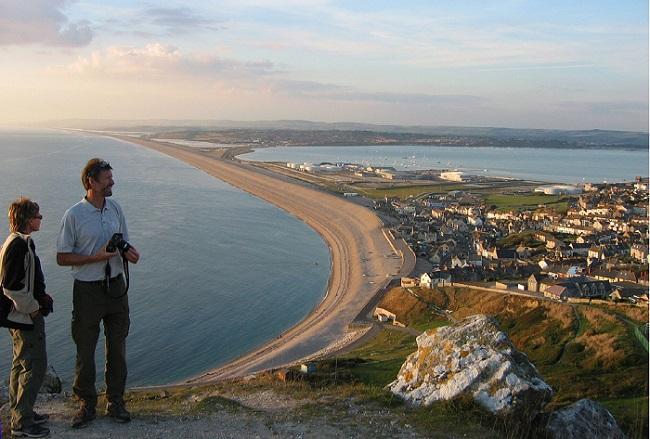
Other geological highlights of the coastline include The towering golden cliffs at West Bay were used as a backdrop for the popular ITV series Broadchurch, while the picturesque harbour and quaint seaside town at Lyme Regis are the heart of Dorset’s fossil-hunting place. In East Devon, don’t miss Orcombe Point Geoneedle in Exmouth, where distinctive red sandstone sea stacks in Ladram Bay are found.
Jurassic Coast England Activities
Take a walk along the South West Coast Path
The South West Coast Running from Minehead in Somerset to Poole Harbour in Dorset (1013 kilometres) Path is the UK’s longest National Trail, taking in 152 kilometres of the Jurassic Coast along the way. Depending on your fitness level, you can walk the whole route in about 10 days, or choose one or two sections for a shorter coast walk. visitors can try the Golden Cap circular walk to climb the highest point on the south coast of England; hit the wild and rugged cliff paths around Portland Bill.
Fossils at Lyme Regis and Charmouth
Lyme Regis is a popular spot for fossil collectors, with new finds being discovered all the time. Look out for the “Ammonite Pavement” on Monmouth Beach, when low tide exposes a rock shelf containing hundreds of fossils. It is a world-famous fossil hunting destination, as Jurassic coast dinosaurs ichthyosaur, discovered, here around 1836.
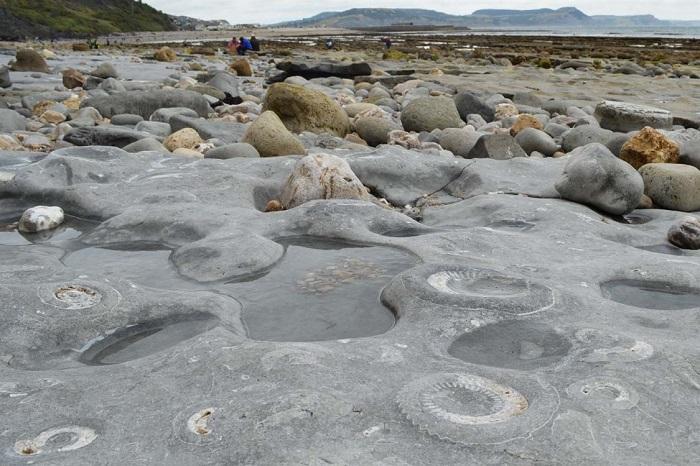
Kimmeridge Bay’s rock pools
The sweeping curve at Kimmeridge Bay is part of a Marine Special Area of Conservation, making it an excellent location for snorkelling and scuba diving. But you can also explore this rich marine life on the beach itself. The bay’s distinctive rock formation shelves are littered with rock pools at low tide. The Wild Seas Centre, a small, free museum on the slipway is worth exploring.
Cool off with a spot of wild swimming
Jurassic Coast England, is a paradise for experienced swimmers, they find exciting pools and hidden coves to plunge into. Chapman’s Pool and Worbarrow Bay offer remote beaches that can only be reached by walking. visitors can also take a drive to the tidal pool at Dancing Ledge, a man-made swimming pool that was blasted into a natural rock shelf in the 19th century for the enjoyment of local people.
Water-sports adventure
Jurassic Coast England is the perfect destination for adventure lovers and thrill-seekers to explore the cliffs and rocks. Old Harry Rocks, Durdle Door and Lulworth Cove are impressive backdrops for a spot of sea kayaking. Weymouth Bay, Studland Bay and Portland Harbour are more sheltered spots and ideal for paddleboarding. Studland Bay, at the eastern end of the Jurassic Coast of England, is one of the UK’s best snorkel sites. You can also try your hand at kitesurfing, windsurfing or sailing lessons at locations along the coast in Portland. Jurassic Coast camping is also the best part of a vacation near the Sea. Dorset is a dream location for camping.
A Ride in historic Seaton Tramway
Take a ride in the historical Seaton Tramway, a network of narrow-gauge heritage trams running through the Axe Valley in East Devon. The colourful open-top trams offer brilliant views of the River Axe estuary and Seaton Wetlands nature reserve. Keep an eye out for local birds and wildlife, including kingfishers, herons and foxes.
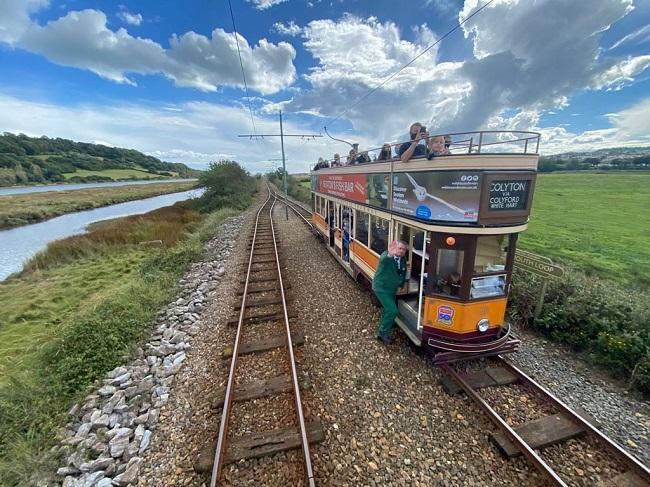
The best times to visit the Jurassic Coast
Summer offers the best view and nice weather for beach days and water sports on the Jurassic Coast. Festivals and events to entice tourists of all interests at this time. Popular spots like Bournemouth Beach and Durdle Door can be very crowded, especially during the summer school holidays. Summer can sometimes be too hot for hiking then the spring and autumn shoulder seasons are ideal for coastal walks. Spring is especially lovely, with blooming wildflowers scattered across the grassy headlands and in the woodlands. Numerous food and seafood festivals run along the coast throughout spring and summer.
Read more- A Brilliant Meander-Shaped Architecture in the Arabian Sea
How to get to the Jurassic Coast of England
The nearest international airports are Bournemouth, Exeter and Southampton, although most visitors from overseas fly from larger London airports. From the airport, it takes about 2 hours to drive to Bournemouth or Poole. From either of these towns, it’s easy to start a road trip along the coast.
The Jurassic coast map shows the area’s Gateway Towns across Dorset and East Devon, the South West Coast Path, museums and visitor centres, and bus routes.
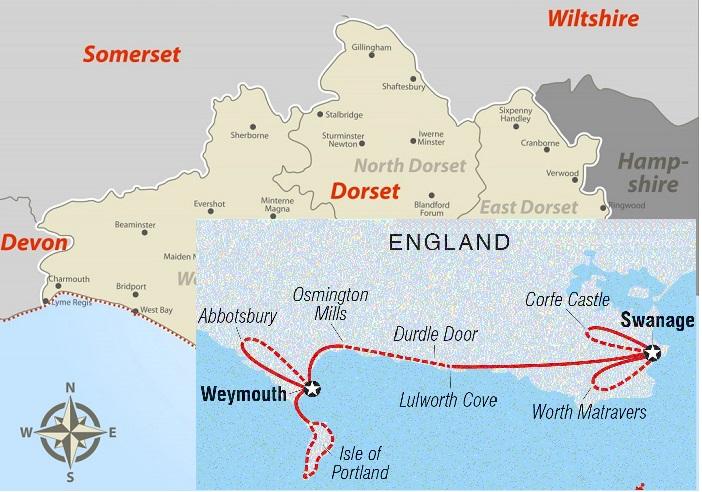
Jurassic coast from London
South Western Railway runs a service from London Waterloo to Weymouth that takes nearly 3 hours to reach. From Weymouth, visitors can use the X53 and X54 Jurassic Coaster buses to travel to most towns between Poole and Axminster. The train from London also runs to Bournemouth and Poole, which is the eastern end of the Jurassic Coast. From here, one can use the Purbeck Breezer services to reach Studland and the Isle of Purbeck.
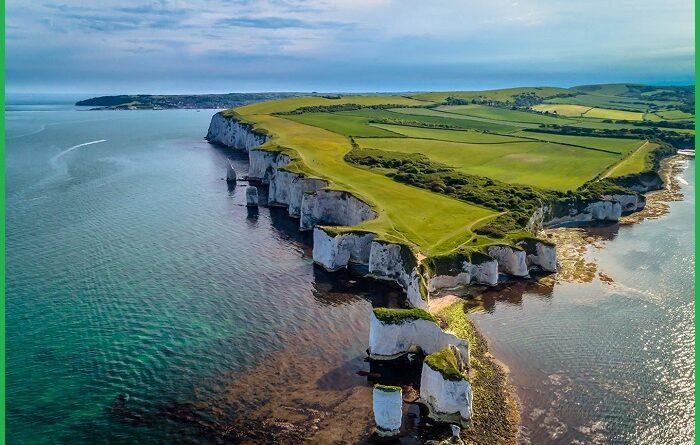
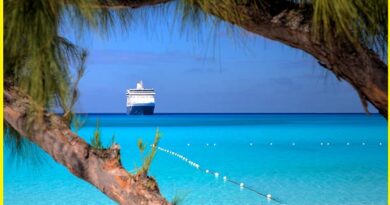

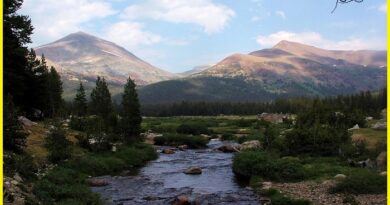
Pingback: How to Plan A trip to These 5 Italy Amalfi Coast Town - Geotourism
Pingback: Most Prominent Geological feature on Earth-The Mid Atlantic ridge valley - Geotourism
Pingback: The Biggest Lie- LIZARD PENINSULA in UK - Geotourism